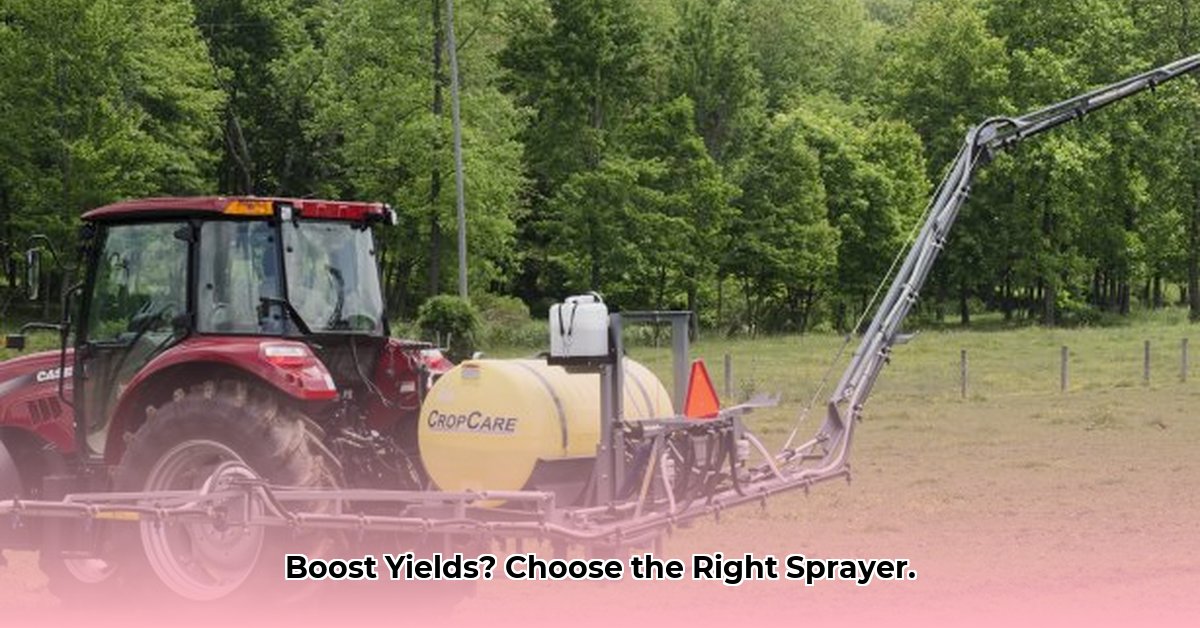
Choosing the right 3-point tractor sprayer is crucial for maximizing crop yields while minimizing environmental impact. This guide provides actionable steps to select, operate, and maintain your sprayer sustainably. It's an investment that directly affects your farm's efficiency and the health of your land. Let's dive in. For even taller crops, consider these tall sprayer options.
Picking the Perfect 3-Point Tractor Sprayer: Size, Power, and Precision
The first step is determining the right sprayer for your specific needs. Several key factors will influence your decision:
Capacity: Matching Tank Size to Your Operation
Tank size is directly related to your farm's acreage and crop types. A small farm might suffice with a 60-gallon tank, while large-scale operations may require significantly larger models—even 1950 gallons or more. Consider your workload and refill convenience when making your selection. Do you want to spend more time spraying or managing refills?
Pump Type: Power and Maintenance Considerations
Roller pumps are generally more affordable and easier to maintain, but might struggle with high-pressure applications. Centrifugal pumps, though more expensive and complex, offer consistent high pressure and greater output. The ideal choice depends on your spraying demands and your mechanical aptitude – are you comfortable with more frequent maintenance?
Boom Width: Balancing Coverage and Drift
Boom width dictates coverage speed. Wider booms increase efficiency but also increase the risk of spray drift. Consider your field size and local wind conditions. A wider boom on a windy day is a recipe for environmental problems. How will you mitigate drift?
Spray Nozzle Types: Targeting Precision and Reducing Drift
Nozzle selection impacts spray pattern, droplet size, and drift. Low-drift nozzles are crucial for minimizing environmental impact. The right nozzle type depends on the specific pesticide and application requirements. What type of nozzle provides the best balance for your crops and local weather patterns?
Essential Features: Enhancing Efficiency and Safety
Look for helpful features such as:
- Agitation systems: Maintain consistent chemical mixing.
- Pressure regulators: Ensure uniform application.
- Rinsing systems: Simplify cleanup and prevent contamination.
Mastering Your 3-Point Tractor Sprayer: Operational Best Practices
Optimizing your sprayer's performance requires careful attention to detail.
Calibration: Achieving Accurate Application Rates
Accurate calibration is paramount for efficient pesticide use. Follow these steps:
- Measure output: Spray over a known distance and time, noting the amount of solution used.
- Calculate rate: Determine the application rate per acre using online calculators or formulas.
- Adjust settings: Fine-tune pressure, speed, and nozzle type to achieve the target rate.
Incorrect calibration wastes resources and may damage crops.
Drift Reduction Techniques: Protecting the Environment
Preventing spray drift is crucial for environmental protection. Here are key strategies:
- Nozzle selection: Use low-drift nozzles designed to minimize overspray.
- Timing: Avoid spraying on windy days. Opt for calm conditions, such as mornings or evenings.
- Temperature: Extreme temperatures exacerbate drift. Avoid spraying during the hottest or coldest periods.
- Additives: Consult your chemical supplier about drift-reducing additives.
Maintenance: Ensuring Longevity and Optimal Performance
Regular maintenance prolongs your sprayer's life and ensures optimal performance. Consult your owner's manual for recommended schedules. Neglecting maintenance invites costly repairs and downtime.
Safety Procedures: Prioritizing Personal and Environmental Safety
Always wear appropriate personal protective equipment (PPE), including gloves, respirator, and eye protection, when handling pesticides. Follow all safety guidelines meticulously.
Sustainable Spraying: Integrating Eco-Conscious Practices
Sustainable agricultural practices are not merely a trend; they are a necessity.
Material Composition and End-of-Life Management
While research on eco-friendly materials in sprayer construction is ongoing, responsible end-of-life management is within your control. Properly dispose of the sprayer and leftover chemicals, adhering to local regulations. Explore recycling options when the time comes.
Precision Agriculture Integration
GPS-guided sprayers and variable-rate technology offer precision application, minimizing pesticide use and environmental impact. This approach maximizes resource efficiency and reduces operational costs.
Comparative Analysis: Making Informed Purchase Decisions
Direct comparisons between models can be challenging due to inconsistent benchmarking. Consult manufacturer specifications, user reviews, and seek advice from agricultural experts before committing to a purchase.
Conclusion: Investing in Efficiency and Sustainability
Choosing the right 3-point tractor sprayer involves careful consideration of multiple factors. By prioritizing capacity, pump type, boom width, nozzle selection, and operational best practices, you can significantly enhance your farm's efficiency while minimizing your environmental footprint. Remember that responsible use and maintenance are key to long-term sustainability.